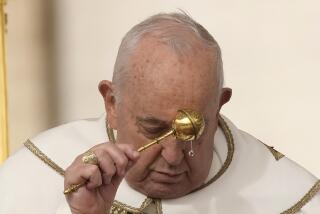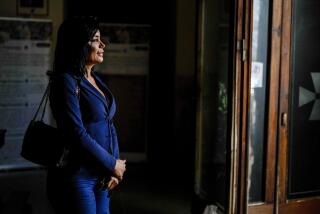Assisi Girds for Throngs Who Will Spend Day Praying for Peace
- Share via
ASSISI, Italy — Pope John Paul II and representatives of most of the world’s great religions will gather here Monday amid pomp and protocol in front of the massive and elaborate Basilica of St. Francis to pray--separately--for world peace.
But just a short walk down the hill from this celebrated medieval town is a down-at-the-heels local institution that may symbolize--better than all of Monday’s ceremonies or the sublime beauty of the town’s 30-odd churches, convents and monasteries--the qualities that make Assisi a place where people of all faiths, or none, often feel closer to reality, or to God.
The place is called San Masseo. A lot of Assisians, mostly small business people who live on the profits of the town’s year-round tourism, are suspicious of it. They complain, as did their ancestors about St. Francis 800 years ago, that its jean-clad Franciscan director, Brother Bernardino, 47, attracts too many guests who look like castaways. The people who come to stay at San Masseo are scruffy, often troubled, and have little or no money to spend, they say.
Franciscan Ritual
The guests of San Masseo--most are clean and well dressed despite the town’s complainers--include many devout Roman Catholics. But there are also Jews, Protestants and non-believers of every race, color and political persuasion. They come to stay for one to three weeks of humble but orderly Franciscan ritual--work, prayer, song and reflection.
“They come here, and it kind of pinches them back to life,” said the stocky, field-hardened Bernardino. “We try to help the kids come out of themselves; contact with nature, with trees, flowers and other creatures, including man, is beneficial.”
San Masseo was once a monastery housing friars of the Capuchin order, one of the three powerful and worldwide Franciscan families that grew from the band of followers of the 12th-Century saint, Francis.
It fell into ruin many years ago and was abandoned, its fields going to scrub and weeds. Today it is a hardscrabble farm, hand-tilled and free of modern agricultural chemicals. The fields surround a cluster of the old monastery’s painstakingly reconstructed stone buildings, one of them containing a crypt that dates from the year 1059. Inside, all the furniture is handmade.
“We make a concentrated effort to keep the natural world the way it is,” Bernardino said.
San Masseo limits its visitors to three-week stays in the rough bucolic setting because Bernardino believes that “for them, this is not the final station. It’s only a pause in the walk of life. I do not want young people or older ones to come here and hide. San Masseo is not here to teach them that this is all they need in life. I want them to go from here and face life.”
One of the few residents who has stayed longer is Patricia Brauner, 37, of Los Angeles, whose experience with horses gave her a role in caring for the farm’s horses and sheep. Today, after six years, she said she has found her place in life, “experiencing a deep inner love for St. Francis” in the same setting where the saint once walked and, according to legend, talked to the animals and the birds.
Collection of Contradictions
By contrast, like many heavily trafficked tourist sites, Assisi itself is a collection of contradictions.
On one level, it has been the destination for countless pilgrims, not just Christians, who admire or revere the teachings and traditions of Francis, his simplicity, self-enforced poverty, passion for peace and respect for all creatures.
That is why the Pope chose it as the site of his inter-religious peace prayers. And why the 25th anniversary conference of the World Wildlife Fund, held here in September, brought Buddhists, Muslims and even Maoris from New Zealand to Assisi.
On another level it is an exceptionally sophisticated country town, even jaded by the parade of famous people who have walked its rough-hewn stone streets and alleyways over the centuries. Britain’s Prince Philip, for example, hardly drew a glance from Assisians a few weeks ago when he was here for the Wildlife Fund conference and paused for a coffee in the Piazza Commune, the town’s broad 13th-Century square.
And on yet another level it is a town with an extraordinarily forgiving sense of humor. The Italian playwright, poet and war hero Gabriele D’Annunzio brought the actress Eleanora Duse here for an illicit tryst, but even when he dressed as a friar and delivered mock sermons from the balcony of his love nest in the Hotel Subasio, Assisians applauded rather than condemned.
Even Col. Valentino Muller, who commanded German Wermacht medical units here during World War II, found a place in the hearts of Assisians, perhaps because he turned a blind eye to the scores of fleeing Jews whom the town hid and fed. Assisi made Muller an honorary citizen after the war, and his unusually humane reign as the occupation commander was later celebrated in the film, “Assisi Underground.”
One of the men who brought food to the Jews hidden in the crypt of the Church of St. Mary Major was Maceo Angeli, now a 78-year-old poet, artist and politician.
Caustic Sense of Humor
According to Angeli, the Assisi sense of humor has a severely caustic side. A lifelong atheist and maverick Communist who keeps portraits of Lenin and St. Francis by his bedside, the professor said with sparkle in his eyes: “I have absolutely no sympathy with the priests, but some of them are my best friends.”
Angeli said that like almost everyone in Assisi he welcomed the Pope and the religious leaders who will gather here Monday. “It will be good for Assisi,” he said, “but if they don’t have the will to make peace, what good will prayer do?”
Msgr. Vittorti Peri, vicar general of the Assisi diocese, was more sanguine about the effectiveness of prayer.
“We are asking people to look into themselves for the causes of war and violence, because they come from inside the person himself,” he said, explaining the purpose behind John Paul’s invitation to 62 international religious leaders, including the Dalai Lama of Tibet and the Church of England’s Archbishop Robert Runcie.
But getting Assisi ready to welcome the more than 50,000 people who want to participate in the World Day of Prayer for Peace has left Peri looking a bit worn.
The anticipated crowd will be the biggest ever to come here, exceeding by at least 10,000 the throng that came to hear Pope John XXIII when he visited Assisi in 1961.
Two Key Decisions
Peri said he is thankful, though, that one of the most sensitive aspects of putting together 11 religions, each divided into two or more sects and groups, for a day of prayer did not fall to the local diocese. Cardinal Roger Etchegaray, head of the Church’s Commission for Justice and Peace, and a team of Vatican organizers solved most of the potential conflicts with two key decisions.
One was to hold the day of prayer on a Monday because, in the words of Bishop Sergio Goretti of Assisi, “it is neither Sunday, the day of the Christians, nor Saturday, the day of the Jews, nor Friday, the day of the Muslims.”
The second was to arrange for the groups to pray apart rather than together, to avoid ruffling the sensitivities of any religious body that might fear it was being preempted by the rituals of another.
“A simple observer might think it would be easy to get a bunch of believers to pray together, but to tell the truth, one should not expect even a communal prayer,” Etchegaray said. “The important thing is to respect the individual prayer of each one, allowing everyone to express himself in the fullness of his faith, according to his religious creed.”
Thus, for the actual prayers for peace, the religions will scatter to separate places in Assisi. Muslims will pray in a room at the Roman temple of Minerva that dates back to the 1st Century B.C. Jews will pray in a small piazza where a synagogue is believed to have been located during the Middle Ages. African Animists will conduct their prayers in the council chambers of the medieval City Hall.
Similarly, Buddhists, Hindus, Zoroastrians, Shintoists, Sikhs, Bahai and dozens of individual sects and branches of most of the major religions will each be assigned a separate site to pray.
“We are coming to Assisi not to pray together, but to be together to pray,” Etchegaray said. “What is involved here is a day of prayer . . . and one needs always to expect a great deal from prayer.”
The cardinal noted that the Pope hopes the day will touch off “a world movement of prayer for peace.” The Pope has also urged terrorists, guerrilla groups and warring nations to lay down their arms at least for the special day.
Peri said he expects the prayer day to go smoothly. But the mayor of Assisi, an ex-schoolteacher named Pietro Profumi, said he is concerned about security and the cost to Assisi’s government.
Assisi has a police force of only 30 traffic officers, he said, so he has had to ask for police help from each of the towns of Umbria, the central region of Italy that includes Assisi. In addition, the government of Italy is sending between 2,000 and 3,000 national police and a unit of its special anti-terrorist force.
The mayor complained that the day will still cost Assisi about $150,000 out of its own budget, with no compensation from state or church. “Still,” he added, “we’re very happy to be chosen for this day; obviously the city will profit from it.”
Many local merchants doubt that. Assisi will be too crowded for anyone to do much shopping or sightseeing Monday, they said.
There remains a sometimes open air of hostility between many of the merchants and the religious institutions of the city. The business people complain that they have been stung by commercial competition from the church. According to one hotelier, he is losing business daily to the religious institutions that maintain a third of the Assisi area’s 7,000 tourist beds.
Complain About Competition
Many of the town’s 200 souvenir shops also complain of unfair competition from the Franciscan friars who run souvenir stands inside the religious buildings.
Some residents said the only thing that worries them about the day of prayer is that the people of Assisi take so much pride in appearing unruffled that they have underestimated the implications of their small town of 3,000 suddenly bursting at the seams with 50,000 or more visitors.
“I quite frankly don’t think that anyone really appreciates how big this event will be,” said Franco Rambotti, 43.
Unlike some Assisians, who he said have lost touch with the natural world that St. Francis loved so deeply around the town, Rambotti said he believes that too much attention has been paid to Assisi as a museum and not enough to the true spirit of the saint who made it famous.
More to Read
Sign up for Essential California
The most important California stories and recommendations in your inbox every morning.
You may occasionally receive promotional content from the Los Angeles Times.










